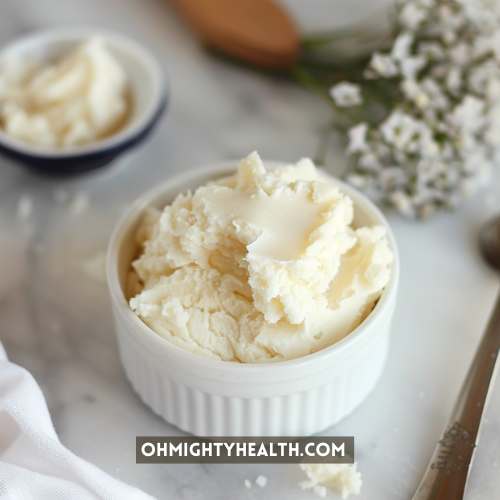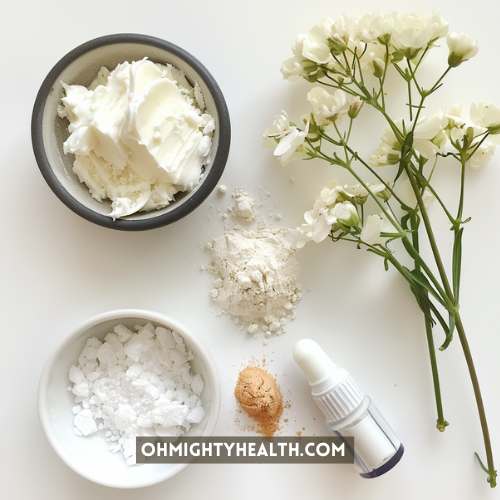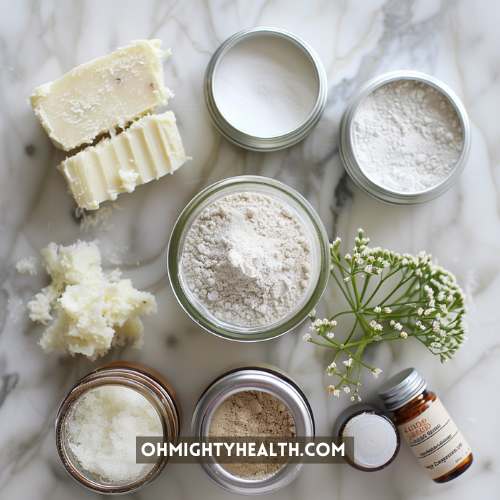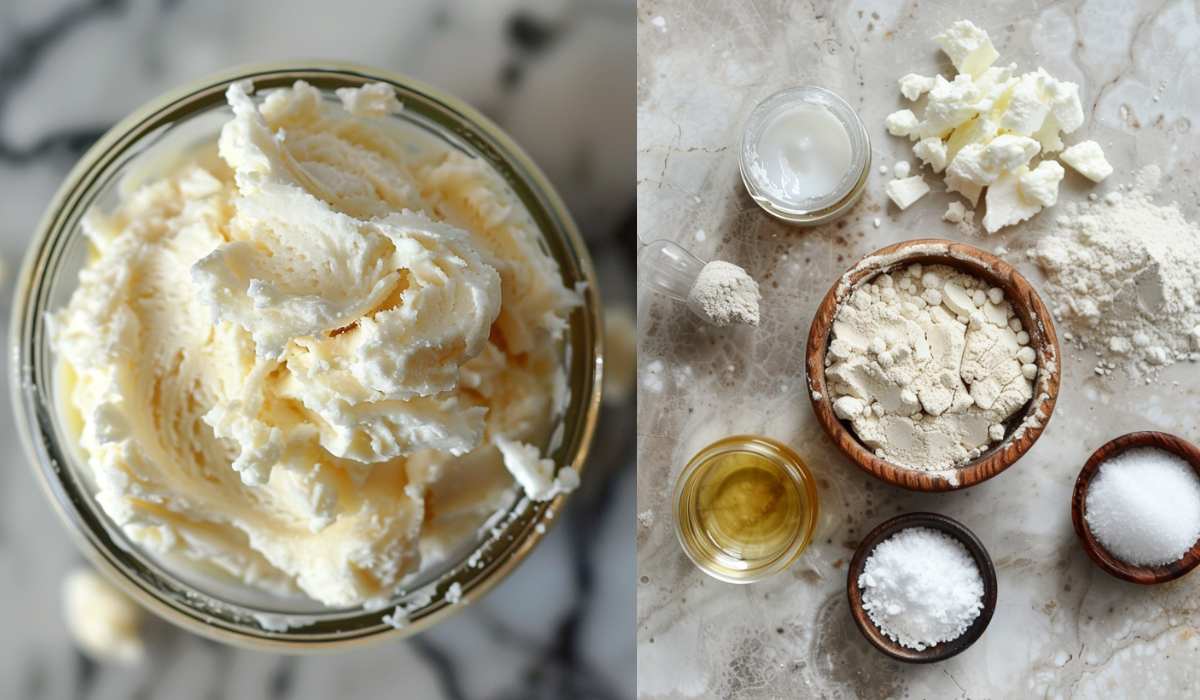DIY Deodorant that Works. I Worked Hard on Perfecting the Formula. Now it’s Yours.
Do you want a deodorant that’s gentle on your skin, completely natural, and actually works?
As a cosmetic formulator passionate about DIY skincare, I’m excited to share a deodorant formula that is the perfect mix between nature and science.
I’m sharing with you my secret formula of a deodorant that will bust odours and keep you fresh without relying on any harsh chemicals. Not even baking soda (which alters the pH of your skin and can irritate over time.)
Putting together this deodorant recipe took some time, but I made sure every ingredient had a special role. They’re all picked to make sure your deodorant is not only natural but also really effective at keeping you smelling great.

While the DIY deodorant includes some ingredients that might seem a bit advanced, they all work together perfectly. Adding them to your DIY deodorant is definitely worth the small effort to learn how.
Just stick to the guide, and making your very own amazing deodorant will be a breeze.
We all have a unique “scent”
Sweat itself is virtually odourless. It’s the bacteria on our skin breaking down sweat into acids that brings that familiar, unwelcome smell. Everyone’s body chemistry is different, meaning we all have a unique “scent.” This DIY recipe tackles sweat and skin bacteria, keeping body odour in check!
Making our deodorant

Here’s a quick look at what each ingredient does in our deodorant recipe.
Shea butter and cocoa butter provide a moisturising base that’s gentle on your skin, while coconut oil brings its antibacterial properties to the fight against odour-causing bacteria. Arrowroot powder and kaolin clay absorb moisture without drying out your skin. Magnesium hydroxide (more on it here) takes care of odour without altering your skin’s natural pH too much, making it a kinder alternative to baking soda. Zinc ricinoleate is a deodorant’s secret weapon, trapping and neutralising odours, while zinc oxide adds an extra layer of odour protection. Essential oils not only give your deodorant a pleasant scent but also add additional antibacterial properties.
What you need
- A small pot for melting ingredients
- A mixing bowl
- A whisk or spoon for stirring
- Deodorant tubes or containers for the final product
Ingredients
This recipe makes 100g of natural deodorant, enough to keep you fresh for months.
There will be affiliate links below, if you purchase through them there will be no extra cost to you and I might earn a commission.
- Shea Butter (30g): Keeps your skin soft and makes the deodorant smooth and easy to apply.
- Coconut Oil (18g): Fights off bacteria that cause odours.
- Arrowroot Powder (18g): Keeps underarms dry by soaking up sweat.
- Kaolin Clay (8g): Helps further absorb moisture and gives the product a silky feel, making application a breeze.
- Magnesium Hydroxide (10g): Gently stops odour, a great alternative to baking soda for sensitive skin.
- Cocoa Butter (10g): Adds firmness and smoothness and provides a slight barrier for skin protection.
- Zinc Oxide (3g): Offers extra help in fighting odour, perfect for sensitive skin.
- Zinc Ricinoleate (2g): Targets and neutralizes odour molecules directly WITHOUT BLOCKING PORES. Link takes you to a German suppliers (at no commission for me). I wholeheartedly trust their products and highly recommend them.
- Essential Oils (1g or about 20-25 drops): Adds a lovely, natural scent and fights germs with antimicrobial properties. I will link to my favourite combination below.
How to make it
- Start with Zinc Ricinoleate pellets: Pop those zinc ricinoleate pellets into your saucepan and gently melt them over low heat. They’re a bit stubborn, so give them time and keep stirring.
- Add the butters and oil: When the pellets start to get a little melty, go ahead and add your shea butter, cocoa butter, and coconut oil to the same pot. This way, everything melts together and gets friendly.
- Mix dry stuff: While the melting party is going on, get your arrowroot powder, magnesium hydroxide, zinc oxide, and kaolin clay into a mixing bowl. Give them a quick stir so they’re all mixed up.
- Combine wet and dry: Once everything in the pot is melted and mixed together nicely, carefully pour it into your bowl of dry ingredients. Stir until everything is well combined. For an even smoother texture, give it a whirl in a blender until it’s totally smooth.
- Scent it up: Let the mix cool just a tad—warm but not hot—then stir in your essential oils for that nice smell and germ-fighting power.
- Pour it out: Scoop or pour your deodorant mix into your containers. If you’re using tubes, make sure they’re ready at the bottom.
- Chill and set: Let your deodorant sit until it’s solid. Room temp works, but the fridge can speed things up if you’re eager.
- Tips:
- Patience with pellets: Zinc ricinoleate takes its sweet time melting, so just keep stirring and keep the heat low.
- No lumps allowed: If you see any clumps while mixing, just whisk a bit more for a creamy texture.
- Skin test: Try a little on your skin once it’s set to make sure everything’s all good.
Melting the pellets first and then adding the butters and oil makes sure everything blends well.
Tips
- Be patient: Melting the zinc ricinoleate pellets might take a bit longer than the other ingredients, so just keep stirring and keep the heat low.
- Smooth consistency: If you notice any lumps while mixing the dry and wet ingredients, don’t hesitate to give it a good whisk. Getting a smooth consistency is key for a pleasant application experience.
- Adjust consistency: If your deodorant is too soft or too hard, adjust the ratios of shea and cocoa butters in your next batch.
- Testing: Once set, do a patch test with your new deodorant to ensure your skin loves it as much as your nose does.
- Storage: Store your deodorant in a cool, dry place to maintain its solid form, especially in warmer months.

Possible essential oils list
Essential oils can add a pleasant scent to your deodorant, and many also have antimicrobial properties that enhance its effectiveness. When selecting essential oils, consider their scent, potential skin benefits, and any known sensitivities or allergies you might have. Here’s a list of popular essential oils for deodorants, along with their properties:
- Tea Tree oil: Known for its powerful antimicrobial and antiseptic properties, making it excellent for neutralizing odor-causing bacteria.
- Lavender oil: Popular for its soothing scent and skin-calming properties. It also has mild antimicrobial effects.
- Lemongrass oil: Offers a fresh, citrus scent with antibacterial and antifungal properties.
- Bergamot oil: Has a fresh, uplifting citrus scent and antimicrobial properties. Note: Choose bergapten-free (FCF) bergamot oil to avoid photosensitivity.
- Eucalyptus oil: Known for its crisp, clean scent and strong antimicrobial properties.
- Rosemary oil: Offers a woody, evergreen scent with antimicrobial and antiseptic qualities.
- Peppermint oil: Provides a cooling sensation and has antibacterial properties. Use sparingly as it can be quite potent.
- Sandalwood oil: Has a warm, woodsy scent and can provide antimicrobial benefits, making it suitable for sensitive skin due to its gentle nature.
- Geranium oil: Offers a floral scent and works as an antibacterial and anti-inflammatory agent.
- Patchouli oil: Known for its earthy aroma and antiseptic, antibacterial, and antifungal properties.
How to Use Essential Oils in Your Formula
- Concentration: Typically, essential oils should make up about 1% of your total formula. For the example formula given (assuming a total weight of 100g), this would mean adding around 1g (or approximately 20-25 drops, depending on the oil’s viscosity) of essential oils.
- Blending for scent: Consider blending two or three oils to create a complex scent profile. For instance, lavender and tea tree oil can provide a balance of soothing and antimicrobial effects, while adding a bit of peppermint can offer a refreshing note.
- Skin sensitivity: Always consider skin sensitivity. Some essential oils, like peppermint and eucalyptus, can be irritating to sensitive skin if used in high amounts. It’s important to do a patch test before widespread use.
Creating a Balanced Blend
A balanced blend for a fresh and unisex scent could combine tea tree oil (for its antimicrobial properties), lavender oil (for a soothing scent), and lemongrass oil (for a fresh, clean note).
A starting point could be 8 drops of tea tree oil, 10 drops of lavender oil, and 7 drops of lemongrass oil, adjusting based on personal scent preferences and sensitivities.
Remember, essential oils are potent, and their efficacy and safety can vary. It’s always a good practice to research and ensure the essential oils you choose are safe for use in skin care products, particularly for the application area intended.
Wrapping up
Congratulations on taking a step towards embracing natural skincare with your DIY deodorant!
This journey not only aligns you with a more sustainable and skin-friendly lifestyle but also empowers you to take control over the ingredients you’re applying to your body daily.
Remember, the process of creating your own deodorant is as much about enjoying the crafting experience as it is about the final product.
You’re not just mixing ingredients; you’re blending your personal touch, preferences, and care into something that keeps you fresh and confident.

